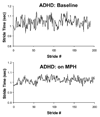Gait dynamics, fractals and falls: finding meaning in the stride-to-stride fluctuations of human walking
- PMID: 17618701
- PMCID: PMC2267927
- DOI: 10.1016/j.humov.2007.05.003
Gait dynamics, fractals and falls: finding meaning in the stride-to-stride fluctuations of human walking
Abstract
Until recently, quantitative studies of walking have typically focused on properties of a typical or average stride, ignoring the stride-to-stride fluctuations and considering these fluctuations to be noise. Work over the past two decades has demonstrated, however, that the alleged noise actually conveys important information. The magnitude of the stride-to-stride fluctuations and their changes over time during a walk - gait dynamics - may be useful in understanding the physiology of gait, in quantifying age-related and pathologic alterations in the locomotor control system, and in augmenting objective measurement of mobility and functional status. Indeed, alterations in gait dynamics may help to determine disease severity, medication utility, and fall risk, and to objectively document improvements in response to therapeutic interventions, above and beyond what can be gleaned from measures based on the average, typical stride. This review discusses support for the idea that gait dynamics has meaning and may be useful in providing insight into the neural control of locomotion and for enhancing functional assessment of aging, chronic disease, and their impact on mobility.
Figures













References
-
- Fatalities and injuries from falls among older adults – United States, 1993–2003 and 2001–2005. MMWR Morb.Mortal.Wkly.Rep. 2006;55:1221–1224. - PubMed
-
- AGS Guidelines. Guideline for the prevention of falls in older persons. American Geriatrics Society, British Geriatrics Society, and American Academy of Orthopaedic Surgeons Panel on Falls Prevention. Journal of the American Geriatrics Society. 2001;49:664–672. - PubMed
-
- Aizen E. Risk factors for falls in the elderly. Harefuah. 2001;140:271–276. - PubMed
-
- Alton F, Baldey L, Caplan S, Morrissey MC. A kinematic comparison of overground and treadmill walking. Clinical Biomechenics (Bristol, Avon) 1998;13:434–440. - PubMed
-
- Ashburn A, Stack E, Pickering RM, Ward CD. A community-dwelling sample of people with Parkinson's disease: Characteristics of fallers and non-fallers. Age Ageing. 2001;30:47–52. - PubMed
Publication types
MeSH terms
Substances
Grants and funding
LinkOut - more resources
Full Text Sources
Other Literature Sources
Medical
Miscellaneous

